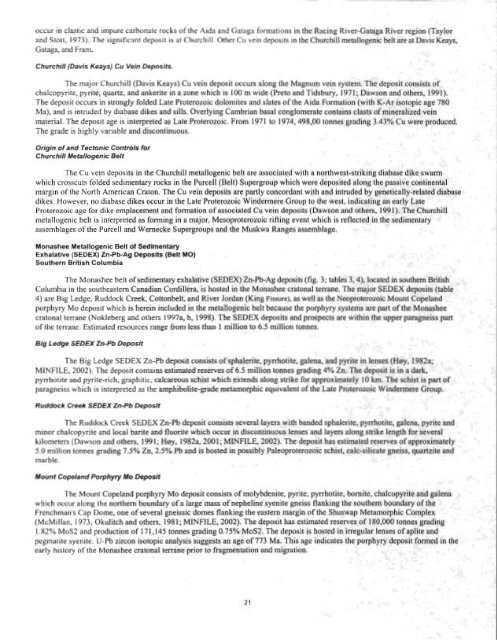Metallogenesis and Tectonics of the Russian Far East, Alaska, and ...
Metallogenesis and Tectonics of the Russian Far East, Alaska, and ...
Metallogenesis and Tectonics of the Russian Far East, Alaska, and ...
You also want an ePaper? Increase the reach of your titles
YUMPU automatically turns print PDFs into web optimized ePapers that Google loves.
occur in clastic <strong>and</strong> impure carbonate rocks <strong>of</strong> <strong>the</strong> Aida <strong>and</strong> Gataga formations in <strong>the</strong> Racing River-Gataga River region (Taylor<br />
<strong>and</strong> Stott, 1973). The significant deposit is at Churchill. O<strong>the</strong>r CLI vein deposits in <strong>the</strong> Churchill metallogenic belt are at Davis Keays,<br />
Gataga, <strong>and</strong> Fram.<br />
Churchill (Davis Keays) Cu Vein Deposits.<br />
The major Churchill (Davis Keays) Cu vein deposit occurs along <strong>the</strong> Magnum vein system. The deposit consists <strong>of</strong><br />
chalcopyrite, pyrite, quartz. <strong>and</strong> ankerite in a zone which is 100 m wide (Preto <strong>and</strong> Tidsbury, 1971; Dawson <strong>and</strong> o<strong>the</strong>rs. 1991).<br />
The deposit occurs in strongly folded Late Proterozoic dolomites <strong>and</strong> slates <strong>of</strong> <strong>the</strong> Aida Formation (with K-Ar isotopic age 780<br />
Ma), <strong>and</strong> is intruded by diabase dikes <strong>and</strong> sills. Overlying Cambrian basal conglomerate contains clasts <strong>of</strong> mineralized vein<br />
material. The deposit age is interpreted as Late Proterozoic. From 197 1 to 1974,498,OO tonnes grading 3.43% Cu were produced.<br />
The grade is highly variable <strong>and</strong> discontinuous.<br />
Origin <strong>of</strong> <strong>and</strong> Tectonic Controls for<br />
Churchill Metallogenic Belt<br />
The Cu vein deposits in <strong>the</strong> Churchill metallogenic belt are associated with a northwest-striking diabase dike swarm<br />
which crosscuts folded sedimentary rocks in <strong>the</strong> Purcell (Belt) Supergroup which were deposited along <strong>the</strong> passive continental<br />
margin <strong>of</strong> <strong>the</strong> North American Craton. The Cu vein deposits are partly concordant with <strong>and</strong> intruded by genetically-related diabase<br />
dikes. However, no diabase dikes occur in <strong>the</strong> Late Proterozoic Windermere Group to <strong>the</strong> west, indicating an early Late<br />
Proterozoic age for dike emplacement <strong>and</strong> formation <strong>of</strong> associated Cu vein deposits (Dawson <strong>and</strong> o<strong>the</strong>rs, 1991). The Churchill<br />
metallogenic belt is interpreted as forming in a major, Mesoproterozoic rifling event which is reflected in <strong>the</strong> sedimentary<br />
assemblages <strong>of</strong> <strong>the</strong> Purcell <strong>and</strong> Wernecke Supergroups <strong>and</strong> <strong>the</strong> Muskwa Ranges assemblage.<br />
Monashee Metallogenic Belt <strong>of</strong> Sedimentary<br />
Exhalative (SEDEX) Zn-Pb-Ag Deposits (Belt MO)<br />
Sou<strong>the</strong>rn British Columbia<br />
The Monashee belt <strong>of</strong> sedimentary exhalative (SEDEX) Zn-Pb-Ag deposits (fig. 3; tables 3,4), located in sou<strong>the</strong>rn British<br />
Columbia in <strong>the</strong> sou<strong>the</strong>astern Canadian Cordillera, is hosted in <strong>the</strong> Monashee cratonal terrane. The major SEDEX deposits (table<br />
4) are Big Ledge, Ruddock Creek, Cottonbelt, <strong>and</strong> River Jordan (King Fissure), as well as <strong>the</strong> Neoproterozoic Mount Copel<strong>and</strong><br />
porphyry Mo deposit which is herein included in <strong>the</strong> metallogenic belt because <strong>the</strong> porphyry systems are part <strong>of</strong> <strong>the</strong> Monashee<br />
cratonal terrane (Nokleberg <strong>and</strong> o<strong>the</strong>rs 1997a, b, 1998). The SEDEX deposits <strong>and</strong> prospects are within <strong>the</strong> upper paragneiss part<br />
<strong>of</strong> <strong>the</strong> terrane. Estimated resources range from less than 1 million to 6.5 million tonnes.<br />
Big Ledge SEDEXZn-Pb Deposit<br />
The Big Ledge SEDEX Zn-Pb deposit consists <strong>of</strong> sphalerite, pyrrhotite, galena, <strong>and</strong> pyrite in lenses (Hnry, 1982a;<br />
MINFILE, 2002). The deposit contains estimated reserves <strong>of</strong> 6.5 million tonnes grading 4% Zn. The deposit is in a dark,<br />
pyrrhotite <strong>and</strong> pyrite-rich, graphitic, calcareous schist which extends along strike for approximately 10 km. The schist is part <strong>of</strong><br />
paragneiss which is interpreted as <strong>the</strong> arnphibolite-grade metamorphic equivalent <strong>of</strong> <strong>the</strong> Late Proterozoic Windermere Group.<br />
Ruddock Creek SEDEX Zn-Pb Deposit<br />
The Ruddock Creek SEDEX Zn-Pb deposit consists several layers with b<strong>and</strong>ed sphalerite, pyrrhotite, galena, pyrite <strong>and</strong><br />
minor chalcopyrite <strong>and</strong> local barite <strong>and</strong> fluorite which occur in discontinuous lenses <strong>and</strong> layers along strike length for several<br />
kilometers (Dawson <strong>and</strong> o<strong>the</strong>rs, 1991; H0y, 1982a, 2001; MINFILE, 2002). The deposit has estimated reserves <strong>of</strong> approximately<br />
5.0 million tonnes grading 7.5% Zn, 2.5% Pb <strong>and</strong> is hosted in possibly Paleoproterozoic schist, calc-silicate gneiss, quartzite <strong>and</strong><br />
marble.<br />
Mount Copel<strong>and</strong> Porphyry Mo Deposit<br />
The Mount Copel<strong>and</strong> porphyry Mo deposit consists <strong>of</strong> molybdenite, pyrite, pyrrhotite, bornite, chalcopyrite <strong>and</strong> galena<br />
which occur along <strong>the</strong> nor<strong>the</strong>rn boundary <strong>of</strong> a large mass <strong>of</strong> nepheline syenite gneiss flanking <strong>the</strong> sou<strong>the</strong>rn boundary <strong>of</strong> <strong>the</strong><br />
Frenchman's Cap Dome, one <strong>of</strong> several gneissic domes flanking <strong>the</strong> eastern margin <strong>of</strong> <strong>the</strong> Shuswap Metamorphic Complex<br />
(McMillan, 1973; Okulitch <strong>and</strong> o<strong>the</strong>rs, 1981; MINFILE, 2002). The deposit has estimated reserves <strong>of</strong> 180,000 tonnes grading<br />
1.82% MoS2 <strong>and</strong> production <strong>of</strong> 171,145 tonnes grading 0.75% MoS2. The deposit is hosted in irregular lenses <strong>of</strong> aplite <strong>and</strong><br />
pegmatite syenite. U-Pb zircon isotopic analysis suggests an age <strong>of</strong> 773 Ma. This age indicates <strong>the</strong> porphyry deposit formed in <strong>the</strong><br />
early history <strong>of</strong> <strong>the</strong> Monashee cratonal terrane prior to fragmentation <strong>and</strong> migration.
















